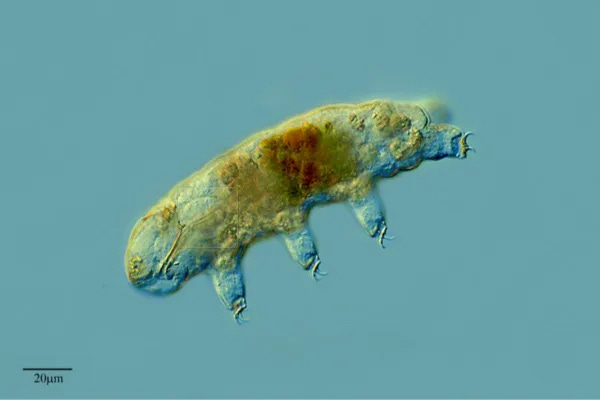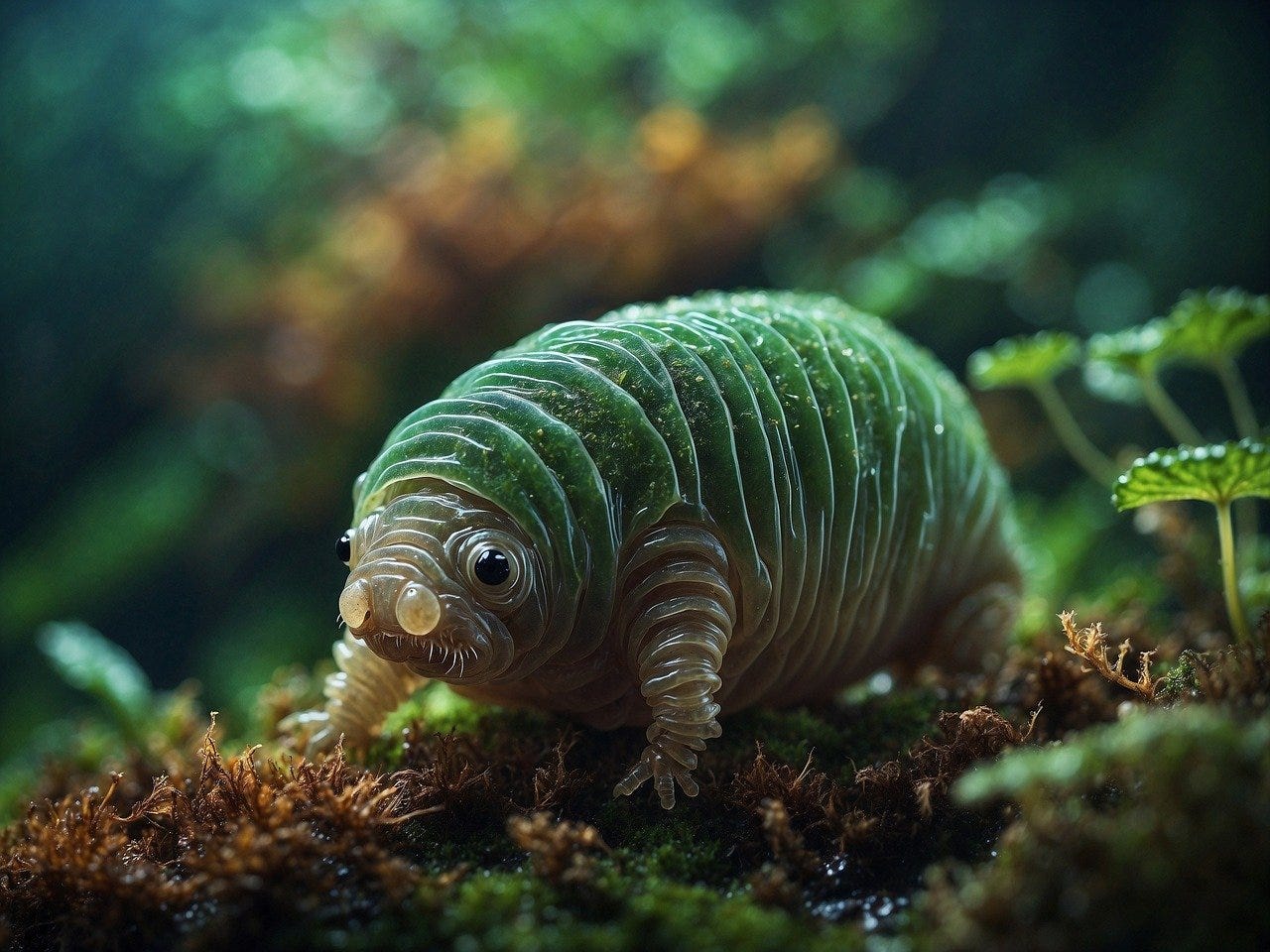About this week’s post: The premise of my Substack is our connectedness, and by “our” I mean all creatures: non-human animals big and small, trees, fungi, microscopic beings, even rocks. There are so many strange and peculiar beings living among us, and I like finding out more about them and sharing with you what I discover. I’ll link some early pieces which you will have missed if you subscribed within the last year: why I love spiders and snakes, the world of fungi and mycelium, the magic of Sea Dragons, or more recently, an article about slime molds, creatures with a deceptive name because they’re neither slimy nor true molds.
When I saw some pictures of tardigrades, they piqued my curiosity: also known as water bears or moss piglets, they not only look intriguing but belong to the most fascinating creatures on earth. They are part of a group of complex organisms called extremophiles, which means they can live and thrive in extreme environments. No matter how extreme it gets, these little critters will survive. Actually, the term isn’t really accurate; while the water bears can tolerate a wide range of extreme environments, they don’t seek them out, the way a true extremophile would. Still, the term is used to characterize their ability to handle extremes.
They were first described by the German pastor and zoologist Johann August Ephraim Goeze who was fascinated by microscopy and discovered the tiny water creatures when he examined some duckweed procured from stagnant water. Using an instrument that magnified objects up to two hundred times, he found what looked like tiny bears to him – so he called them kleine Wasserbären, “little water bears”.
Barely visible to the naked eye, they are indeed tiny: they measure only 0.05 - 1.5 millimeters, which equals 0.002 - 0.06 inches. Only the largest of the 1,500 known species, about the size of a grain of salt, could be seen without magnification.

They look somewhat otherworldly: they have two ‘simple’ eyes or ocelli, which means they have a single lens without an elaborate retina; four pairs of short, stubby legs; each leg has one or more claws and can move both backwards and forwards. They can be found in just about any environment, in freshwater and in the sea (even at depths of more than 15,000 feet), in damp habitats such as mosses and lichens, but also in sand and high mountains (in the Himalayas at over 19,000 feet). No wonder scientists call them cosmopolitan!

The natural course of a tardigrade’s life spans about three to 30 months, and yet – they can survive 30 years and more without food and water! We’ll get to that. Their bodies are covered with a tough cuticle which makes them extremely resilient. They also have sensory bristles – hairlike growth called cirri which reacts to chemical and tactile stimuli.
What makes them so remarkable is the tardigrades’ ability to withstand and survive conditions which would kill almost any other living creatures. Boiling or freezing temperatures, irradiation, extreme pressure, space vacuum – these tiny creatures can survive it all. No water for long periods of time? Extreme cold, such as 30 years at −4 °F? Extreme heat, such as a few minutes at 304 °F? No oxygen? No problem.

They manage this because they can enter a state of suspended metabolism called Cryptobiosis. All metabolic processes stop. When there’s no water available, tardigrades draw in their legs and form a desiccated cyst, also called the dehydrated ‘tun’ state. Their water content drops to less than 1%, their metabolism slows to 0.01% of normal, and they enter a death-like state called tun. They enter this state in response to the extreme environmental conditions listed above, and they can enter different kinds of tun-states depending on the actual emergency situation: when there is no water, they enter anhydrobiosis, when it’s extremely cold, they protect themselves with cryobiosis. Anhydrobiosis gives tardigrades resistance to a lack of water, but also to a number of physical factors such as high temperature, radiation or different kinds of chemicals, such as ethanol, hydrogen sulphide and carbon dioxide. They don’t need any food or water while in a tun state, and when their surroundings return to normal, they wake up as if nothing had happened – scientists discovered some water bears that had been in a tun-state for over 30 years.
In addition, tardigrades can withstand pressures of up to 87,000 pounds per square inch (600 megapascals). Almost all other living beings on Earth would perish with just half of this pressure.
In 2007, the Russian science satellite FOTON-M3 took some tardigrade species on a twelve-day mission into space, the first animals known to survive such a trip. Active as well as specimens in tun-state were exposed to the vacuum and the radiation of space. Most of them had no problem with either, some even laid eggs during the journey!1
Knowing that tardigrades can survive high levels of radiation, scientists tested their tolerance against gamma-rays and heavy ions, their short- and long-term survival, as well as their ability to reproduce after irradiation. The conclusion: “At 48 h after irradiation, median lethal doses were 5000 Gy (gamma-rays) and 6200 Gy (heavy ions) in hydrated animals, and 4400 Gy (gamma-rays) and 5200 Gy (heavy ions) in anhydrobiotic ones”. More than 1000 Gy makes them sterile.
These numbers didn’t mean much to me, so I tried to convert and compare them to levels that would be dangerous/fatal for humans. Not so easy! “Gy” is the symbol for “Gray”, the international unit measuring ionizing radiation. In humans, radiation sickness can occur at levels greater than 0.7 Gy, and exposure to anything higher than 30 Gy causes death. Tardigrades can handle up to 1000 Gy without problems – that’s immensely impressive.
HOW do tardigrades manage to perform all these fantastic feats? Researchers are still trying to find out, and it surpasses my scientific understanding to summarize what they know so far. It has to do with IDPs, “intrinsically disordered proteins”, which somehow remain stable under excessive heat. And they form protective glasses that shield cells and vital enzymes from dehydration. If you’re interested, the linked article from MIT will tell you more.
I find myself torn about the experiments that these poor critters are exposed to. On the one hand, we’d know very little about the cute moss piglets; although they can be easily seen with any normal microscope, we wouldn’t have any idea about their amazing ability to withstand extreme heat, cold, or radiation. On the other hand, some research is done in order to learn whether humans could possibly live on Mars. That doesn’t justify killing thousands or millions of tardigrades. If you have a strong opinion about this, leave a comment – it’s a difficult conundrum.
No matter how you feel about scientific experiments, make sure to listen to Cosmo Sheldrake’s Tardigrade Song!
And if you want to learn more about tardigrades and observe them moving around, watch the video below.





I love that little guy
oh . . . now i'm in love with tardigrades / i'm so interested in connectivity and contacts - you made contact with me / great post / lot's of research and extra features / i appreciate your style